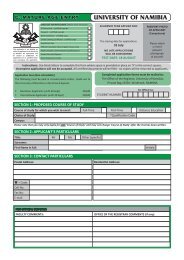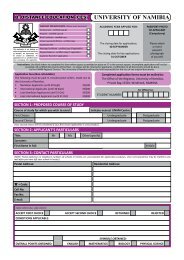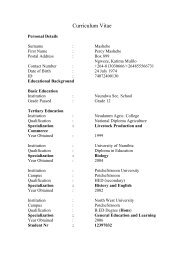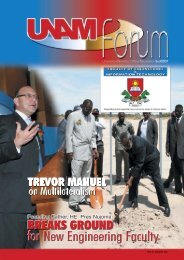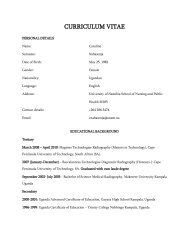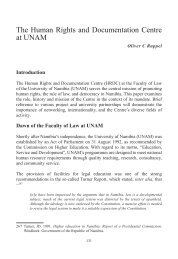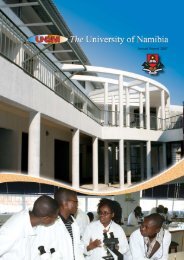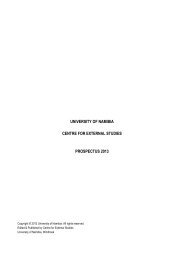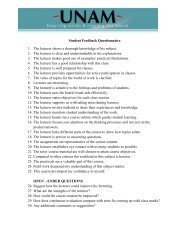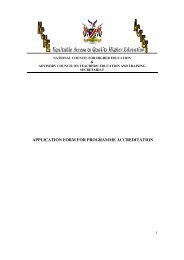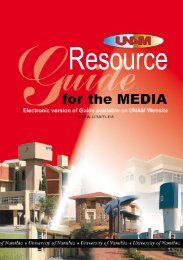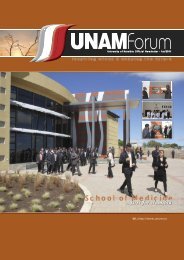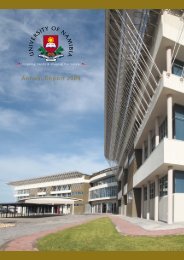5Year Strategic Plan - University of Namibia
5Year Strategic Plan - University of Namibia
5Year Strategic Plan - University of Namibia
You also want an ePaper? Increase the reach of your titles
YUMPU automatically turns print PDFs into web optimized ePapers that Google loves.
2.3. Quality and Relevance Challenges<br />
The principal contribution <strong>of</strong> a university to society lies on the quality <strong>of</strong> the knowledge it generates<br />
and imparts, the habits <strong>of</strong> critical thinking it institutionalizes and inculcates in its graduates and the<br />
values its promotes and demonstrates. Quality performance <strong>of</strong> a university is determined by indirect<br />
indicators such as the calibre and commitment <strong>of</strong> teaching and research staff; the range and quality<br />
<strong>of</strong> curricula and pedagogy and the quality and extent <strong>of</strong> educational facilities including the means <strong>of</strong><br />
accessing traditional as well as world-wide knowledge.<br />
Quality staff, systems, values, resources and facilities are key to maintaining high levels <strong>of</strong> teaching<br />
and scholarship, while vibrant research with a strong component <strong>of</strong> fieldwork leads not only to the<br />
production <strong>of</strong> international quality work but also to the rise <strong>of</strong> knowledge centres <strong>of</strong> excellence<br />
in particular fields. Reduced government subsidy and increased training costs lead to inadequate<br />
physical facilities, slow down in staff development and thus poor quality staff. The situation is<br />
aggravated by the replacement <strong>of</strong> senior experienced academic staff with junior staff. All these bring<br />
about the erosion <strong>of</strong> some key factors which help to guarantee the quality <strong>of</strong> university education.<br />
The conditions that respect and provide adequate means for the cultivation <strong>of</strong> quality knowledge are<br />
becoming less favourable, while the percentage <strong>of</strong> academic staff across faculties remains quite low<br />
and some departments are experiencing under-staffing. The challenge for UNAM is to review its<br />
policies and fill gaps that impact on quality <strong>of</strong> education and research productivity.<br />
2.4. Enrolment and Capacity Challenges<br />
In recent years we have seen phenomenal increases in student enrolment while infrastructure in terms<br />
<strong>of</strong> lecture rooms, laboratories and halls <strong>of</strong> residence have remained nearly the same. Substantial<br />
expansion <strong>of</strong> both primary and secondary education leading to a sustained pool <strong>of</strong> secondary school<br />
graduates vying to join university education as well as civil servants wishing to upgrade their<br />
qualifications, have contributed to the massification <strong>of</strong> university education. Nevertheless, its is<br />
important to note that despite remarkable expansion <strong>of</strong> enrolment, the gross enrolment ratio, that is,<br />
the proportion <strong>of</strong> young people aged 19-24 that is in university is on the average quite low in <strong>Namibia</strong><br />
and the SADC Region as a whole, and can be regarded as inadequate for the demands <strong>of</strong> a modern<br />
knowledge economy.<br />
24



